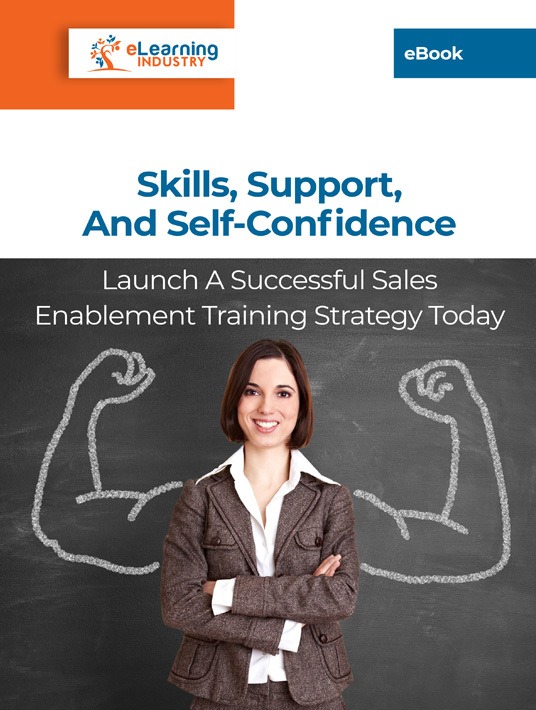What Is Missing From Your Sales Enablement Strategy?
Is your sales enablement training strategy up to modern employees’ standards? Does it align with your current online training needs and objectives? You expect your staffers to represent your brand and point out all the unique selling points to ensure that everyone who walks through the door, calls in, or sets up a meeting gets the VIP treatment. But are you extending that same courtesy to your in-house talent? Are they getting the best possible sales enablement solutions that your company has to offer? These 7 tips can help you spot hidden gaps in your plan to enrich the online training experience and retain top talent.

1. Collect Employee Feedback
Employees are responsible for getting the information they need to facilitate CX that lives up to your brand image. But are you giving them ongoing support? Does your sales enablement strategy involve real-world application? Are they able to cultivate relevant skills to uphold their end of the deal? Collect their eLearning feedback to identify gaps and disclose personal preferences. Surveys, focus groups, and interviews are just a few ways to gather their input and enact meaningful change.
2. Evaluate LMS Metrics
LMS metrics give you a window into employee performance, progress, proficiency, and areas for improvement that feedback tools often overlook because staffers are simply unaware of the pain points. For example, they don’t even realize they lack the necessary product knowledge to land more sales. Participation, engagement, completion times, and assessment scores are all key metrics to consider during your sales enablement training evaluation.
3. Take A Closer Look At Business Reports
Business reports are another essential indicator of sales enablement strategy effectiveness. For instance, slow sales tell you that employees may need more JIT training tools to seal the deal. Or that they lack crucial competencies to provide superb CX, such as interpersonal skills. Maybe the problem lies with task performance. Analyze business reports to see the connection between training issues and real-world applicability. They might be absorbing all the theories and policies, but can they use them on the job?
4. Conduct Customer Surveys
Customers must interact with your staff to get the product info they need and make a better buying decision. So, conduct surveys to disclose gaps that are only visible on the receiving end. Does it take half an hour to complete a relatively simple transaction because your employee doesn’t know how to use the system? Is a customer frustrated by your sales team’s lack of product know-how, such as the features and benefits? Do they walk away feeling like they got the best possible experience? Or did the sales employee ignore them because they were busy helping a "high ticket" customer?
5. Identify Crucial Employee Training Touchpoints
Employees require training all throughout their career. From the moment they sign on to your organization, you need to encourage personal growth and self-evaluation. Identify crucial touchpoints wherein you can make a difference in their lives—and your profit margin. For example, you should reach out after they complete the onboarding certification course to evaluate their performance as well as verify that your new hire training program is on point. There are numerous stages in the employment cycle where additional guidance is integral. Or even after notable sales training activities that may require follow-up, such as live events and online discussions that disclose personal gaps.
6. Evaluate On-The-Job Performance
Every customer who brings in business should feel special. In their personal lives, this might involve dinner and a show. In this business world, this translates into personalized service that bolsters customer loyalty. But how do you determine whether your employees are up to company standards and provide standout service? There are two common ways to evaluate their workplace performance, aside from customer surveys. The first is to enlist the help of team leaders to observe performance behaviors in the real world. The second is to incorporate simulations, branching scenarios, and other interactive evaluation methods to identify gaps. For instance, the employee training participant struggles with communication skills and is unable to land the sale during the simulation. Or they don’t know how to ring up the purchase in the POS system. As such, they’ll probably make the same mistake on the job and continually miss sales opportunities.
7. Assess After Each Activity
Many organizations test employees at the end of onboarding and during yearly refresher courses. But that’s it. The secret to sales enablement solutions success is to assess after each activity. It doesn’t have to be blatant evaluations that put staffers on edge, like those dreaded compliance written exams. Even simulations and games can disclose hidden pain points and point employees in the right direction, as well as help you identify underlying training issues that hinder their performance. For example, 75% of your sales employee training participants "failed" the simulation, and they all share similar skill and knowledge gaps. This is a tell-tale sign that there’s a bigger problem with your sales enablement strategy. It’s not giving employees the tools they need to achieve their full potential, which has a direct impact on sales and CX.
Unfortunately, gaps won’t simply go away if you take a "wait-and-see" approach to employee development. They require a proactive sales enablement strategy that involves regular Training Needs Analysis and eLearning feedback. You must be willing to dive deep into assessment scores, LMS metrics, and employee opinions to personalize the online training content. As well as solicit customer input to evaluate things from the receiving end so that you can accurately gauge the overall CX.
If you want to learn more about implementing successful sales operations training, download our eBook Skills, Support, And Self-Confidence: Launch A Successful Sales Enablement Training Strategy Today. You will find all the information you need to train your sales team so that they gain the expertise and confidence they need to skyrocket their performance and offer unparalleled Customer Experience.

